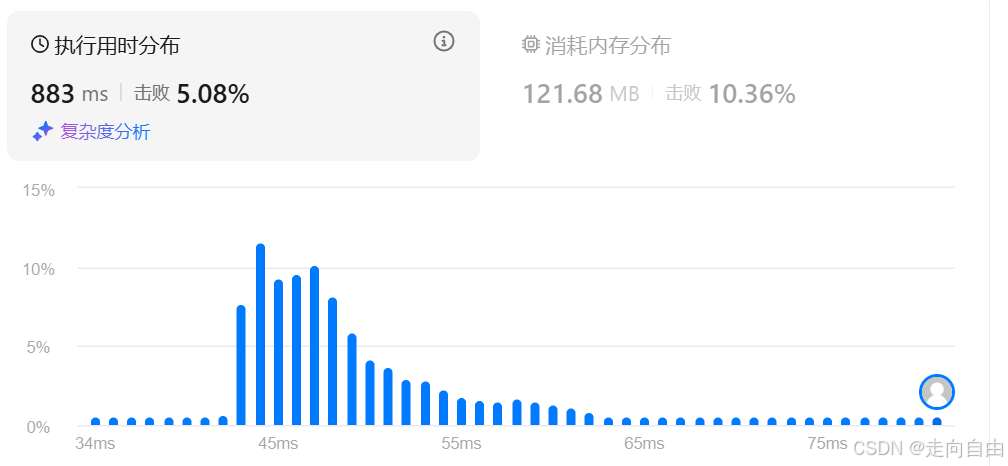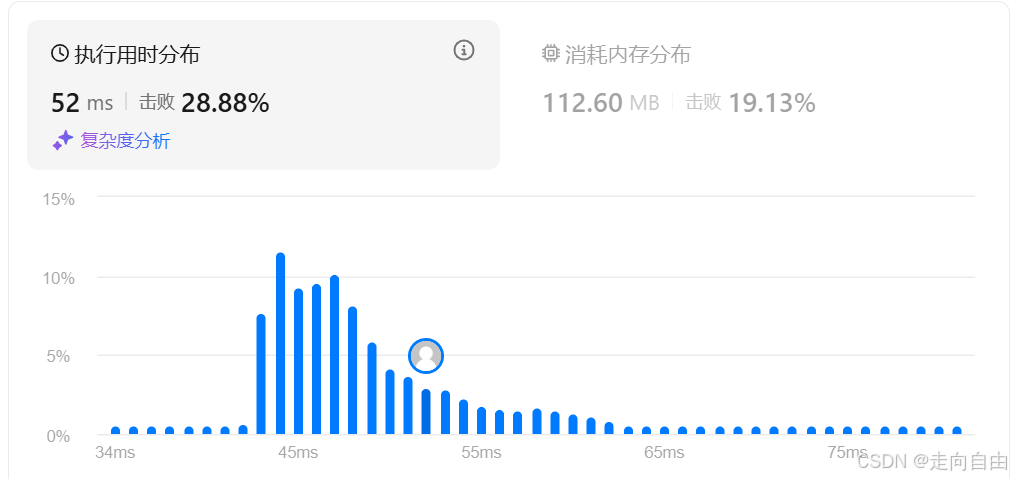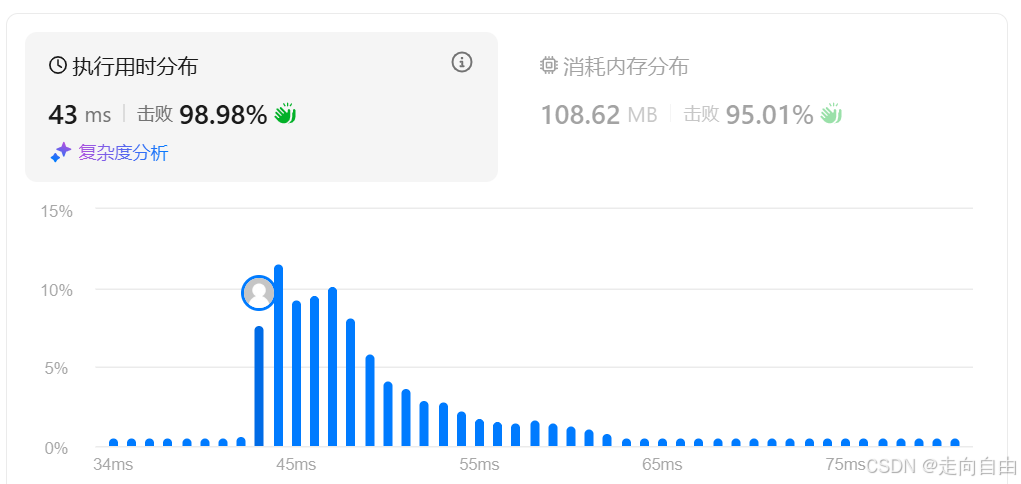请你设计并实现一个满足 LRU (最近最少使用) 缓存 约束的数据结构。
实现
LRUCache类:
LRUCache(int capacity)以 正整数 作为容量capacity初始化 LRU 缓存int get(int key)如果关键字key存在于缓存中,则返回关键字的值,否则返回-1。void put(int key, int value)如果关键字key已经存在,则变更其数据值value;如果不存在,则向缓存中插入该组key-value。如果插入操作导致关键字数量超过capacity,则应该 逐出 最久未使用的关键字。函数
get和put必须以O(1)的平均时间复杂度运行。示例:
输入 ["LRUCache", "put", "put", "get", "put", "get", "put", "get", "get", "get"] [[2], [1, 1], [2, 2], [1], [3, 3], [2], [4, 4], [1], [3], [4]] 输出 [null, null, null, 1, null, -1, null, -1, 3, 4] 解释 LRUCache lRUCache = new LRUCache(2); lRUCache.put(1, 1); // 缓存是 {1=1} lRUCache.put(2, 2); // 缓存是 {1=1, 2=2} lRUCache.get(1); // 返回 1 lRUCache.put(3, 3); // 该操作会使得关键字 2 作废,缓存是 {1=1, 3=3} lRUCache.get(2); // 返回 -1 (未找到) lRUCache.put(4, 4); // 该操作会使得关键字 1 作废,缓存是 {4=4, 3=3} lRUCache.get(1); // 返回 -1 (未找到) lRUCache.get(3); // 返回 3 lRUCache.get(4); // 返回 4提示:
1 <= capacity <= 30000 <= key <= 100000 <= value <= 105- 最多调用
2 * 105次get和put
解法1:Map + ArrayList (key)
用一个Map来存放key和value,一个ArrayList来存放访问顺序。
当用户get、put的key存在时,则从ArrayList中找到对应的key删除,然后把新访问的key放到尾部。
头部表示最久未访问的数据,尾部表示最新访问的数据。与数据结构匹配。
java
class LRUCache {
private int capacity;
private Map<Integer,Integer> cache;
private List<Integer> delete;
public LRUCache(int capacity) {
this.cache = new HashMap<>(capacity);
this.capacity = capacity;
this.delete = new ArrayList<>(capacity);
}
public int get(int key) {
Integer value = cache.get(key);
if(value != null){
// update to delete queue
delete.remove((Integer)key);
delete.add((Integer)key);
return value;
}
return -1;
}
public void put(int key, int value) {
// if existed
if (cache.containsKey(key)) {
// update to delete queue
delete.remove((Integer)key);
delete.add((Integer)key);
cache.put(key, value);
return;
}
// if cache is full, need to delete
if(cache.size() == capacity){
Integer deleteKey = delete.remove(0);
cache.remove(deleteKey);
}
cache.put(key, value);
delete.add(key);
}
}
/**
* Your LRUCache object will be instantiated and called as such:
* LRUCache obj = new LRUCache(capacity);
* int param_1 = obj.get(key);
* obj.put(key,value);
*/
性能不怎么好,花了883ms。大部分时间花在ArrayList中查找key的位置和删除key后移动元素上了。
那我们想办法改进下,查找和删除。
解法2:Map + ArrayList (key, timestamp)
我们看到解法1中大部分时间都是在ArrayList中查找key和删除后移动数据。那么我们能不能不移动数据?答案是可以的。
方法是:我们每次操作key后为其引入一个timestamp,需要删除这个key时,比较待删除的timestamp是否没有更新过,没更新过则删除。这里使用程序启动后的纳秒,防止在同一个微秒内完成了多个操作,不能区分。
java
class LRUCache {
private int capacity;
private Map<Integer,KeyTime> cache;
private List<KeyTime> delete;
public LRUCache(int capacity) {
this.capacity = capacity;
this.cache = new HashMap<>(capacity*3/2);
this.delete = new LinkedList<>();
}
public int get(int key) {
KeyTime kt = cache.get(key);
if(kt != null){
long time = System.nanoTime();
kt.time = time;
// update to delete queue
delete.add(new KeyTime(key, kt.value, time));
return kt.value;
}
return -1;
}
public void put(int key, int value) {
long time = System.nanoTime();
// if existed
KeyTime kt = cache.get(key);
if (kt != null) {
kt.time = time;
kt.value = value;
// update to delete queue
delete.add(new KeyTime(key, value, time));
return;
}
// if cache is full, need to delete
if(cache.size() == capacity){
while(true) {
KeyTime deleteKt = delete.remove(0);
KeyTime existKt = cache.get(deleteKt.key);
if (existKt != null && existKt.time == deleteKt.time) {
cache.remove(deleteKt.key);
break;
}
}
}
cache.put(key, new KeyTime(key, value, time));
delete.add(new KeyTime(key, value, time));
}
static class KeyTime {
int key;
int value;
long time;
public KeyTime(int key, int value, long time) {
this.key = key;
this.value = value;
this.time = time;
}
}
}
/**
* Your LRUCache object will be instantiated and called as such:
* LRUCache obj = new LRUCache(capacity);
* int param_1 = obj.get(key);
* obj.put(key,value);
*/
性能已经从883ms提升到了52ms,历史性的飞跃。还不错,可惜才28.88%,要是还想进一步优化的话,可以参考官方的LinkedHashMap实现。
解法3:HashMap + 双向链表 = LinkedHashMap
这里get/put 后把新访问的节点移动到表尾处,表头存放的是最久未访问的数据。
具体实现如下:
java
public class LRUCache {
/**
* use double direction linked list to store the order which to evict over due key.
*/
private int capacity;
private Map<Integer,Node> cache;
// store the first node to delete which is unused for a long time
private Node head;
// store the used node recently
private Node tail;
public LRUCache(int capacity) {
this.capacity = capacity;
this.cache = new HashMap<>(capacity);
this.head = new Node(-1, 0, null, null);
this.tail = new Node(-2, 0, head, null);
this.head.next = tail;
}
public int get(int key) {
Node node = cache.get(key);
if (node != null) {
// existed then move to head
moveToTail(node);
return node.value;
}
return -1;
}
public void put(int key, int value) {
Node node = cache.get(key);
if (node != null) {
// existed, only need to update position
moveToTail(node);
node.value = value;
return;
}
// cache is full, get the last unused node to remove
if (cache.size() == capacity) {
// remove the head node which is unused for a long time
Node toDelete = head.next;
deleteNode(toDelete);
cache.remove(toDelete.key);
}
node = new Node(key, value, null, null);
cache.put(key, node);
addToTail(node);
}
static class Node {
int key;
int value;
Node previous;
Node next;
public Node(int key, int value, Node previous, Node next) {
this.key = key;
this.value = value;
this.previous = previous;
this.next = next;
}
}
public void moveToTail(Node node) {
deleteNode(node);
addToTail(node);
}
/**
* delete node from list.
*/
public void deleteNode(Node node) {
node.previous.next = node.next;
node.next.previous = node.previous;
}
/**
* add node to list tail.
*/
public void addToTail(Node node) {
node.next = tail;
node.previous = tail.previous;
tail.previous.next = node;
tail.previous = node;
}
}
运行时间43ms,超越98.98%,可以了。